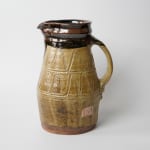Murata Gen 村田 元 Japanese, 1904-1988
H29.2 x W21.5 x D17.7 cm
Further images
-
(View a larger image of thumbnail 1
)

-
(View a larger image of thumbnail 2
)

-
(View a larger image of thumbnail 3
)

-
(View a larger image of thumbnail 4
)

-
(View a larger image of thumbnail 5
)

-
(View a larger image of thumbnail 6
)

-
(View a larger image of thumbnail 7
)

-
(View a larger image of thumbnail 8
)

Murata Gen (1904-2008) was a dedicated and masterful Mingei potter. His first encounter with pottery was late, relative to many potters in his life, when he visited a folk craft exhibition showcasing Mashiko wares in Tokyo. Inspired by the modest beauty of Mashiko pottery, he decided to relocate permanently to Mashiko in 1924, where studied for many years under Hamada Shoji and affiliated closely with the Mingei school, British potter Bernard Leach, Shimaoka Tatsuzo, and others.
Murata’s training in classical painting foregrounds his mastery over surface-scape. His functional wares employ unique glaze decoration to express scenic vistas. Like Hamada Shoji, Murata Gen chose to use only clay and glazes indigenous to Mashiko; he was a mindful Mingei practitioner that built his clay works with intention.
Murata Gen (1904-2008) was a dedicated and masterful Mingei potter. His first encounter with pottery was late, relative to many potters in his life, when he visited a folk craft exhibition showcasing Mashiko wares in Tokyo. Inspired by the modest beauty of Mashiko pottery, he decided to relocate permanently to Mashiko in 1924, where studied for many years under Hamada Shoji and affiliated closely with the Mingei school, British potter Bernard Leach, Shimaoka Tatsuzo, and others.
Murata’s training in classical painting foregrounds his mastery over surface-scape. His functional wares employ unique glaze decoration to express scenic vistas. Like Hamada Shoji, Murata Gen chose to use only clay and glazes indigenous to Mashiko; he was a mindful Mingei practitioner that built his clay works with intention.







